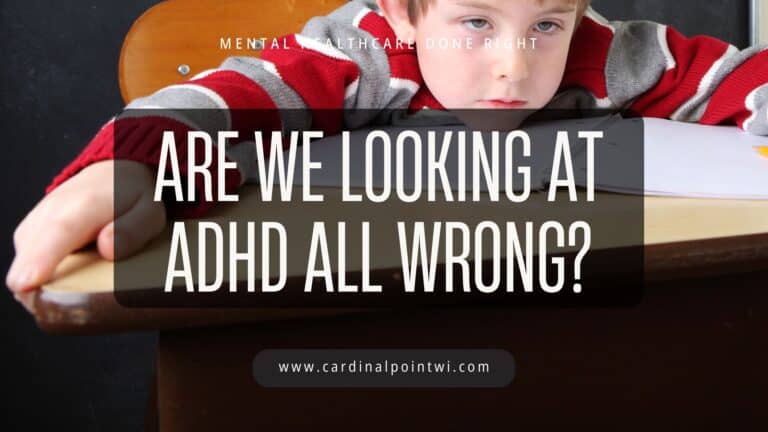When we talk about ADHD, the conversation almost always starts and ends with symptoms: inattention, hyperactivity, impulsivity. From there, the mental health world tends to rush straight into diagnostic labels and medication management. But maybe we’ve been looking at ADHD all wrong. Maybe ADHD isn’t simply a “disorder” to be medicated away—it could be a different way of experiencing the world that we’ve pathologized because it doesn’t fit neatly into a rigid system.
The Lens Problem
For decades, ADHD has been defined through a deficit-based lens. Even the name—Attention-Deficit/Hyperactivity Disorder—is loaded with judgment. The assumption is that something is broken, lacking, or malfunctioning. But what if the “deficit” isn’t in the individual, but in the way we measure and value attention?
In our society, attention is rewarded when it’s linear, task-oriented, and sustained. But attention that is fluid, creative, and divergent often gets flagged as problematic. This isn’t to say ADHD doesn’t create real struggles—executive functioning challenges, emotional dysregulation, and burnout are very real. But it does mean we should ask: is the problem within the person, or is it in the context they’re forced to operate in?
The Myth of Chemical Imbalance
We often hear that ADHD is caused by a “dopamine deficiency” or a “chemical imbalance” in the brain. But here’s the truth: there’s no solid scientific evidence to support that theory. In fact, research has never proven that people with ADHD inherently produce less dopamine. The “chemical imbalance” narrative was a marketing slogan, not a scientific fact.
So why do medications seem to help? Because stimulant drugs don’t actually correct a chemical imbalance—they alter neurotransmitter activity in a way that increases short-term compliance. Kids may sit still longer, and adults may grind through tasks they otherwise find intolerable. But studies show medications don’t necessarily improve long-term educational outcomes. They don’t teach new skills, foster creativity, or help someone find purpose—they mainly make people easier to manage in rigid systems.
The Environment Mismatch
Consider this: many people with ADHD thrive in environments that are stimulating, flexible, and aligned with their passions. They struggle in environments that are rigid, repetitive, or uninspiring. Yet, we often expect children (and adults) to conform to systems built for uniformity—like traditional classrooms or 9-to-5 office jobs.
When someone can’t thrive in that context, we label them “disordered.” But maybe the real issue is a mismatch between human diversity and societal structures.
Beyond Medication
Medication can help some people manage symptoms, but it shouldn’t be the only answer. Too often, treatment starts and ends with a prescription, with little attention to lifestyle, environment, nutrition, movement, sleep, or even creativity as therapeutic tools.
What if we reframed ADHD treatment around optimizing strengths, building supportive environments, and fostering regulation through holistic strategies? What if, instead of suppressing traits, we helped people channel them?
Flipping the Script
Some of history’s greatest innovators, artists, and entrepreneurs might meet criteria for ADHD today. Their restless energy, quick-thinking, and ability to connect seemingly unrelated dots were not deficits—they were the very traits that fueled their impact.
This doesn’t erase the challenges ADHD brings. But it does suggest we need to flip the script: ADHD isn’t just about what’s “wrong” with someone—it’s about understanding the whole person in context.
A New Way Forward
What if the mental health world started asking different questions?
Instead of “How do we fix these symptoms?” ask: “How can we build environments where this person thrives?”
Instead of “What’s the deficit?” ask: “What strengths are hiding in plain sight?”
Instead of “How do we quiet the ADHD brain?” ask: “How do we support it to flourish?”
Maybe we’ve been looking at ADHD all wrong. Maybe it’s time to shift from pathologizing difference to embracing neurodiversity. Because when we stop trying to fit every mind into the same mold, we open up space for everyone to contribute in their own way.
✅ Medically Reviewed Statement
This article has been medically reviewed for accuracy and balance by Dr. Teralyn Sell, PhD. While ADHD symptoms are real and can create challenges, there is no scientific consensus that ADHD is caused by a chemical imbalance or lack of dopamine production. Current evidence shows that stimulant medications may increase compliance in structured settings but do not improve long-term educational outcomes. Always consult with a licensed healthcare provider before making decisions about diagnosis or treatment.






